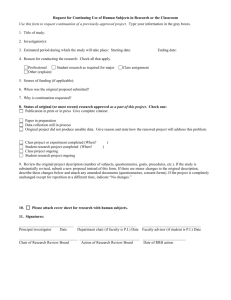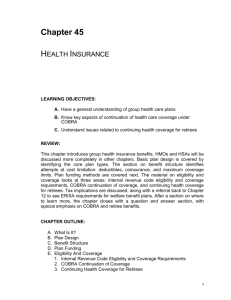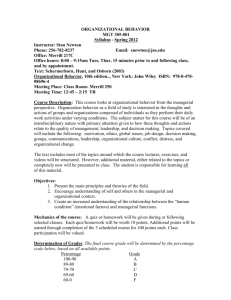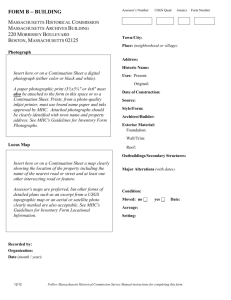Sample Wrap Document (Editable)
advertisement
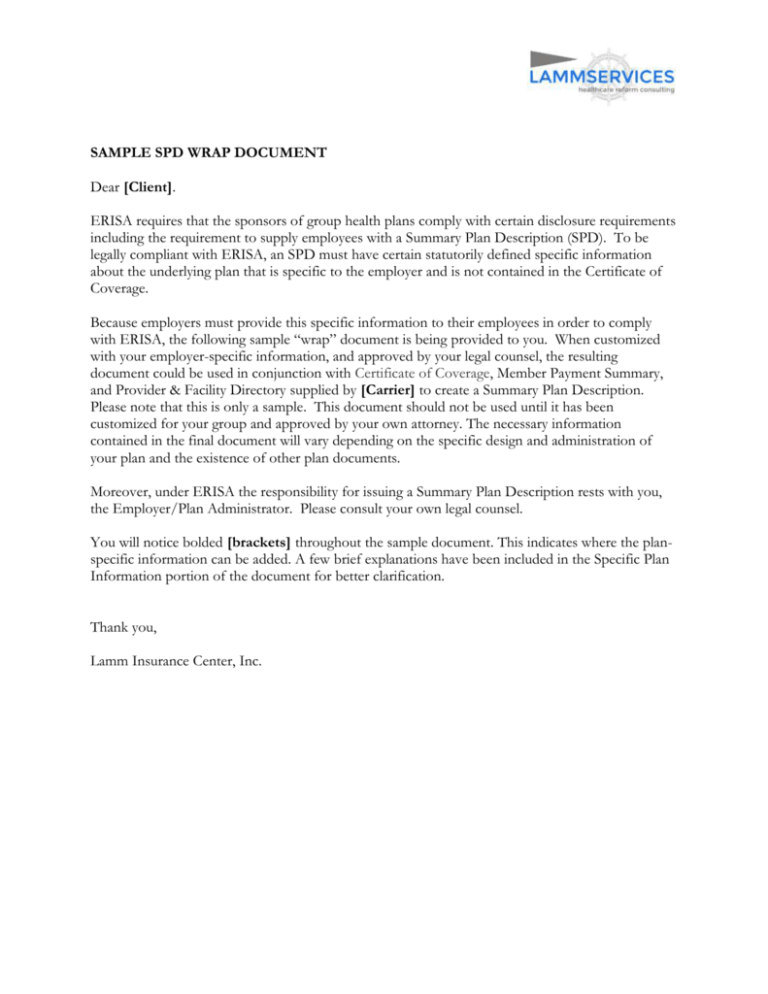
SAMPLE SPD WRAP DOCUMENT Dear [Client]. ERISA requires that the sponsors of group health plans comply with certain disclosure requirements including the requirement to supply employees with a Summary Plan Description (SPD). To be legally compliant with ERISA, an SPD must have certain statutorily defined specific information about the underlying plan that is specific to the employer and is not contained in the Certificate of Coverage. Because employers must provide this specific information to their employees in order to comply with ERISA, the following sample “wrap” document is being provided to you. When customized with your employer-specific information, and approved by your legal counsel, the resulting document could be used in conjunction with Certificate of Coverage, Member Payment Summary, and Provider & Facility Directory supplied by [Carrier] to create a Summary Plan Description. Please note that this is only a sample. This document should not be used until it has been customized for your group and approved by your own attorney. The necessary information contained in the final document will vary depending on the specific design and administration of your plan and the existence of other plan documents. Moreover, under ERISA the responsibility for issuing a Summary Plan Description rests with you, the Employer/Plan Administrator. Please consult your own legal counsel. You will notice bolded [brackets] throughout the sample document. This indicates where the planspecific information can be added. A few brief explanations have been included in the Specific Plan Information portion of the document for better clarification. Thank you, Lamm Insurance Center, Inc. [Company Name] [Company Name] Health & Welfare Plan Summary Plan Description [Plan Date] 2 Introduction [Company Name] (the “Employer”) maintains the [Company Name] Health & Welfare Plan (“the Plan”) for the exclusive benefit of its eligible employees and their eligible dependents. Benefits under the Plan are currently provided under a group health insurance contract (“the Group Health Insurance Contract”) entered into between the Employer and [Carrier]. Plan benefits, including information about eligibility, are summarized in the Certificate of Coverage, Member Payment Summary, and Provider & Facility Directory issued by [Carrier], copies of which are available from your Human Resources Department, free of charge. These documents together with this document constitute the Summary Plan Description required by the federal law known as the Employee Retirement Income and Security Act (“ERISA”). Capitalized terms not otherwise defined in this document are defined in the Certificate of Coverage. Specific Plan Information Plan Name: [Company Name] Health & Welfare Plan - This is the formal name of the ERISA Plan that includes health benefits, e.g. the “XYZ Company Employee Health Plan.” Type of Plan: A group health & welfare plan (a type of welfare benefits plan subject to the provisions of ERISA). Plan Year: January 1 to December 31 - Company plan year Plan Number: 501 – This is the number you have assigned the Plan for purposes of filing a Form 5500 with the Dept. of Labor. If you haven’t assigned a number yet—perhaps because you are exempt from filing 5500’s—you should do so now and record it here. If you do not have other, numbered welfare plans, 501 is a good place to start. Employer / Plan Sponsor: [Name of Employer] [Address] Plan Funding and Type of Administration: The Plan is fully insured. Benefits are provided under the Group Health Insurance Contract between the Employer and [Carrier]. Claims for benefits are sent to [Carrier], which is responsible for paying claims. [Carrier] and the Employer share responsibility for administering the Plan. Insurance premiums for employees and their eligible dependents are paid in part by the Plan Sponsor out of its general assets, and in part by employees’ payroll deductions. 3 Plan Sponsor’s Employer Identification Number: Example = 12-3456789 - This is the same as the employer’s Tax ID number. Plan Administrator: [Name of Employer, Person or Committee – The Plan Administrator is typically the company, but could also be a committee or other representative designated by the company.] [Address] [Telephone] Attention: [Name of Designee] Named Fiduciary: [Name of Employer, Person or Committee – The Named Fiduciary is typically the company, but could also be a committee or other representative designated by the company.] [Address] [Telephone] Agent for Service of Legal Process: [Name of Person] [Address] [Telephone Number] Service of process may also be made on the Plan Administrator. Important Disclaimer: Plan benefits are provided under a Group Health Insurance Contract between the Employer and [Carrier]. If the terms of this summary document conflict with the terms of the Group Health Insurance Contract, the terms of the Group Health Insurance Contract will control, unless superseded by applicable law. ID Cards You will be issued an ID Card after you enroll with the carrier. Please carry your ID Card with you and present it each time you receive care. If you lose your ID Card, you can request a new one by calling [Carrier] member services or contacting your Human Resources Department. Eligibility [For Large Employers (more than 50 employees) insert:] You are eligible to participate in the Plan if: [insert Employer’s Specific Employee Eligibility Info]. 4 [For Small Employers (2-50 employees) insert:] In order to be Eligible for Benefits you must be scheduled to work 30 or more hours per week. During the Employer Waiting Period, you must work the specified minimum required hours except for paid time off and hours you do not work due to a medical condition, the receipt of healthcare, your health status or disability. [Carrier] may require payroll reports from your employer to verify the number of hours you have worked as well as documentation from you to verify hours that you did not work due to paid time off, a medical condition, the receipt of healthcare, your health status or disability. To determine whether your spouse and dependent children are eligible to participate in the Plan, please read the eligibility information contained in the Certificate of Coverage issued by [Carrier]. The Plan will extend benefits to dependent children placed with you for adoption under the same terms and conditions as apply in the case of dependent children who are your natural children. Also eligible is any child covered under a Qualified Medical Child Support Order (QMCSO) as defined by applicable law and determined by your Employer under its QMCSO procedures, a copy of which is available from your Human Resources Department, free of charge. If eligible, you must complete an application form to enroll in the Plan and [Carrier] (available from your Human Resources Department) or otherwise comply with your Employer’s enrollment procedures. Coverage will terminate if you no longer meet the eligibility requirements. Coverage may also terminate if you fail to pay your share of the premium, if your hours drop below the required eligibility threshold, if you submit false claims, etc. (See the Certificate of Coverage for more information.) Coverage for your spouse and dependents stops when your coverage stops. Their coverage will also stop for other reasons specified in the Certificate of Coverage. Special Situations, Extension of Coverage [FMLA does not apply to: (1) employers that do not employ 50 or more employees during 20 or more calendar workweeks in current or preceding calendar year; (2) employees at worksites with less than 50 employees, if the employer employs fewer than 50 employees within a 75-mile radius of that worksite. Employers who may meet one of these exceptions should consult with their legal counsel about removing this section.] Family and Medical Leave Act (FMLA) If the Family Medical Leave Act (FLMA) applies to your Employer and you qualify for an approved family or medical leave of absence (as defined in the FMLA), eligibility may continue for the duration of the leave if required contributions are paid toward the cost of the coverage. Your Employer has the responsibility to provide you with prior written notice of the terms and conditions under which payment must be made. Failure to make payment within 30 days of the due date established by your Employer will result in the termination of coverage. Subject to certain exceptions, if you fail to return to work after the leave of absence, your Employer has the right to recover from you any contributions toward the cost of coverage made on your behalf during the leave, as outlined in the FMLA. If coverage is terminated for failure to make payments while you are on an approved family or medical leave of absence, coverage for you and your eligible dependents will be automatically reinstated on the 5 date you return to employment if you and your dependents are otherwise eligible under the plan. Any waiting period for pre-existing conditions or other waiting periods will not apply. However, all accumulated annual and lifetime maximums will apply. If you do not return to work at the end of an FMLA leave, you may be entitled to elect COBRA Continuation Coverage, even if you were not covered under the Plan during the leave. Coverage continued under this provision is in addition to coverage described below under the section entitled “Continuation Coverage (COBRA).” The Plan intends to comply with all existing FMLA regulations. If for some reason the information presented differs from actual FMLA regulations, the Plan reserves the right to administer the FMLA in accordance with such actual regulations. Military Leave Coverage The Uniformed Services Employment and Reemployment Rights Act (USERRA) establishes requirements that employers must meet for certain employees who are involved in the uniformed services As used in this provision, “Uniformed Services” means: The Armed Forces; The Army National Guard and the Air National Guard when engaged in active duty for training, inactive duty training, or full-time National Guard duty (pursuant to orders issued under federal law); The commissioned corps of the Public Health Service; and Any other category of persons designated by the President in time of war or national emergency. As used in this provision, “Service in the Uniformed Services” or “Service” means the performance of a duty on a voluntary or involuntary basis in a Uniformed Service under competent authority and includes: Active duty; Active duty for training; Initial active duty training; Inactive duty training; Full-time National Guard duty, A period for which you are absent from your job for purpose of an examination to determine your fitness to perform any such duties; A period for which you are absent from your job for the purpose of performing certain funereal honors duty; and Certain service by intermittent disaster response appointees of the National Disaster Medical System (NDMS). If you were covered under this Plan immediately prior to taking a leave for Service in the Uniformed Services, you may elect to continue your coverage under USERRA for up to 24 months from the date your leave for uniformed service began, if you pay any required contributions toward the cost of the 6 coverage during the leave. This USERRA continuation coverage will end earlier if one of the following events takes place: 1) You fail to make a premium payment within the required time; 2) You fail to report to work or to apply for reemployment within the time period required by USERRA following the completion of your service; or 3) You lose your rights under USERRA, for example, as a result of a dishonorable discharge. If the leave is 30 days or less, your contribution amount will be the same as for active employees. If the leave is longer than 30 days, the required contribution will not exceed 102% of the cost of coverage. Coverage continued under this provision runs concurrently with coverage described below under the section entitled “COBRA Continuation Coverage.” If your coverage under the Plan terminated because of your Service in the Uniformed Services, your coverage will be reinstated on the first day you return to employment if you are released under honorable conditions and you return to employment within the time period(s) required by USERRA. When coverage under this Plan is reinstated, all of the Plan’s provisions and limitations will apply to the extent that they would have applied if you had not taken military leave and your coverage had been continuous. This waiver of limitations does not provide coverage for any illness or injury caused or aggravated by your military service, as determined by the VA. (For complete information regarding your rights under USERRA, contact your Employer.) The Plan intends to comply with all existing regulations of USERRA. If for some reason the information presented in the Plan differs from the actual regulations of USERRA, the Plan reserves the right to administer the plan in accordance with such actual regulations. [COBRA applies to employers with who employ 20 employees on a typical business day during the preceding calendar year (meaning it had 20 or more employees on at least 50% of its typical business days during that year). Employers who may meet this exception should consult with their legal counsel about removing this section. COBRA Continuation Coverage COBRA Continuation Coverage is a continuation of Plan coverage when coverage would otherwise end because of a life event known as a “qualifying event.” The following are qualifying events: • Termination of your employment for any reason except gross misconduct. Coverage may continue for you and/or your eligible dependents; • A reduction in your hours. Coverage may continue for you and/or your eligible dependents; • Your death. Coverage may continue for your eligible dependents; • Your divorce or legal separation. Coverage may continue for your eligible dependents; 7 • Your becoming entitled to Medicare. Coverage may continue for your eligible dependents; and • Your covered dependent child’s ceasing to be a dependent child under the Plan. Coverage may continue for that dependent. [If your Plan includes retiree coverage, this section will have to be modified to include Employer bankruptcy as a qualifying event.] Note: To choose this continuation coverage, an individual must be covered under the Plan on the day before the qualifying event. In addition, your newborn child or child placed for adoption with you during a period of continuation coverage will remain eligible for continuation coverage for the remaining period of coverage even if you and/or your spouse terminate continuation coverage following the child’s birth or placement for adoption. Notification Requirements Under the law, you or the applicable dependent has the responsibility to inform the Plan Administrator, in writing, within 60 days of a divorce or legal separation or of a child losing dependent status under the Plan. Failure to provide this written notification within 60 days will result in the loss of continuation coverage rights. Your Employer has the responsibility to notify the Plan Administrator of your death, termination of employment, reduction in hours, or entitlement to Medicare within 30 days of the qualifying event. Subject to the Plan Administrator being informed in a timely manner of the qualifying events described in the above paragraphs, the Plan will promptly notify you and other qualifying individual(s) of their continuation coverage rights. You and any applicable dependents must elect continuation coverage within 60 days after Plan coverage would otherwise end, or, if later, within 60 days of the notice of continuation coverage rights. Failure to elect continuation coverage within this 60-day period will result in loss of continuation coverage rights. Trade Act of 2002 If you qualify for Trade Adjustment Assistance (TAA) as defined by the Trade Act of 2002, they you will be provided with an additional 60 day enrollment period, with continuation coverage beginning on the date of such TAA approval. Notice of Unavailability of Continuation Coverage If the Plan Administrator receives a notice of a qualifying event from you or your dependent and determines that the individual (you or your dependent) is not entitled to continuation coverage, the Plan Administrator will provide to the individual an explanation as to why the individual is not entitled to continuation coverage. This notice will be provided within the same time frame that the Plan Administrator would have provided the notice of right to elect continuation coverage. Maximum Period of Continuation Coverage 8 The maximum period of continuation coverage is 36 months from the date of the qualifying event, unless the qualifying event is your termination of employment or reduction in hours. In that case, the maximum period of continuation coverage is generally 18 months from the date of the qualifying event. However, if a qualifying individual is disabled (as determined under the Social Security Act) at the time of your termination or reduction in hours or becomes disabled at any time during the first 60 days of continuation coverage, continuation coverage for the qualifying individual and any nondisabled eligible dependents who are also entitled to continuation coverage may be extended to 29 months provided the qualifying individual or dependent, if applicable, notifies the Plan Administrator in writing within the 18-month continuation coverage period and within 60 days after receiving notification of determination of disability. If a second qualifying event occurs (for example, your death or divorce) during the 18- or 29-month coverage period resulting from your termination of employment or reduction in hours, the maximum period of coverage will be computed from the date of the first qualifying event, but will be extended to the full 36 months if required by the subsequent qualifying event. A special rule applies if the qualifying individual is your spouse or dependent child whose qualifying event was the termination or reduction in hours of your employment and you became entitled to Medicare within 18 months before such qualifying event. In that case, the qualifying individual’s maximum period of continuation coverage is the longer of 36 months from the date of your Medicare entitlement or their otherwise applicable maximum period of coverage. Cost of Continuation Coverage The cost of continuation coverage is determined by the Employer and paid by the qualifying individual. If the qualifying individual is not disabled, the applicable premium cannot exceed 102 percent of the Plan’s cost of providing coverage. The cost of coverage during a period of extended continuation coverage due to a disability cannot exceed 150 percent of the Plan’s cost of coverage. Premium payments for continuation coverage for you or your eligible dependent’s “initial premium month(s)” are due by the 45th day after electing continuation coverage. The “initial premium month(s)” are any month that ends on or before the 45th day after you or the qualifying individual elects continuation coverage. All other premiums are due on the first of the month for which coverage is sought, subject to a 30-day grace period. Premium rates are established by your Employer and may change when necessary due to Plan modifications. The cost of continuation coverage is computed from the date coverage would normally end due to the qualifying event. Failure to make the first payment within 45 days or any subsequent payment within 30 days of the established due date will result in the permanent cancellation of continuation coverage. When Continuation Coverage Ends Continuation of coverage ends on the earliest of: 1. The date the maximum continuation coverage period expires; 2. The date your Employer no longer offers a group health plan to any of its employees; 3. The first day for which timely payment is not made to the Plan; 9 4. The date the qualifying individual becomes covered by another group health plan. However, if the new plan contains an exclusion or limitation for a pre-existing condition of the qualifying individual, continuation coverage will end as of the date the exclusion or limitation no longer applies; 5. The date the qualifying individual becomes entitled to coverage under Medicare; and 6. The first day of the month that begins more than 30 days after the qualifying individual who was entitled to a 29-month maximum continuation period is subject to a final determination under the Social Security Act that he or she is no longer disabled. Note: The Health Insurance Portability and Accountability Act of 1996 (HIPAA) requires that all health insurance carriers that offer coverage in the individual market accept any eligible individuals who apply for coverage without imposing a pre-existing condition exclusion. In order to be eligible to apply for such coverage from a carrier after ceasing participation in the Plan, you or your eligible dependents must elect continuation coverage under the Plan, continue through the maximum continuation coverage period (18, 29, or 36 months, as applicable), and then apply for coverage with the individual insurance carrier before a 63 day lapse in coverage. For more information about your right to such individual insurance coverage, contact an independent insurance agent or your state insurance commissioner. Notice of Termination Before Maximum Period of COBRA Coverage Expires If continuation coverage for a qualifying individual terminates before the expiration of the maximum period of continuation coverage, the Plan Administrator will provide notice to the individual of the reason that the continuation coverage terminated, and the date of termination. The notice will be provided as soon as practicable following the Plan Administrator’s determination regarding termination of the continuation coverage. The Plan intends to comply with all applicable law regarding continuation (COBRA) coverage. If for some reason the information presented in this Plan differs from actual COBRA requirements, the Plan reserves the right to administer COBRA in accordance with such actual COBRA requirements. Summary of Plan Benefits The Plan provides eligible employees and their eligible dependents with health insurance. These benefits are provided under the Group Health Insurance Contract with [Carrier]. A summary of the benefits provided under the Plan is in the Certificate of Coverage issued by [Carrier]. The Plan, through the Group Health Insurance Contract, provides benefits in accordance with the applicable requirements of federal laws, such as Employee Retirement Income Security Act (ERISA), Consolidated Omnibus Budget Reconciliation Act (COBRA), Health Insurance Portability Accountability Act (HIPAA), Newborns’ and Mothers’ Health Protection Act (NMHPA), Mental Health Parity Act (MHPA), and the Women’s Health and Cancer Rights Act (WHCRA). Plan Administration The administration of the Plan is under the supervision of the Plan Administrator. The principal duty of the Plan Administrator is to see that the Plan is carried out, in accordance with its terms, for the exclusive benefit of persons entitled to participate in the Plan without discriminating among them. 10 The Plan is fully insured. Benefits are provided under the Group Health Insurance Contract entered into between the Employer and [Carrier]. Claims for benefits are sent to [Carrier], and [Carrier], not the Employer, is responsible for paying them. [Carrier] is also responsible for determining eligibility for and the amount of any benefits payable under the Plan and prescribing claims procedures and forms to be followed to receive Plan benefits. [Carrier] also has the discretionary authority to require participants to furnish it with such information as it determines is necessary for the proper administration of claims for Plan benefits. Claims and Appeals [Carrier] is responsible for evaluating all benefit claims under the Plan. [Carrier] will decide your claim in accordance with its reasonable claims procedures, as required by ERISA. If your claim is denied, you may appeal to [Carrier] for a review of the denied claim and [Carrier] will decide your appeal in accordance with its reasonable procedures, as required by ERISA. See the Certificate of Coverage for complete details regarding [Carrier] claims and appeals procedures. Amendment or Termination of the Plan As Plan Sponsor, the Employer has the right to amend or terminate the Plan at any time. You have no vested or permanent rights or benefits under the Plan. Plan benefits will typically change from year-to-year and you should examine the SPD provided to you each year to determine the benefits of the Plan. No Contract of Employment The Plan is not intended to, and does not, either directly or indirectly constitute any form of employment contract or other employment arrangement between you and Employer. Other Materials The Certificate of Coverage (including the Member Payment Summary, and the Provider & Facility Directory) issued by [Carrier] are part of the Summary Plan Description. Please refer to these materials for other important provisions regarding your participation in the Plan. YOUR RIGHTS UNDER THE EMPLOYEE RETIREMENT INCOME SECURITY ACT (ERISA) As a participant in the Plan (which is a type of employee welfare plan called a “group health plan”) you are entitled to certain rights and protections under the Employee Retirement Income Security Act of 1974 (ERISA). ERISA provides that all group health plan participants shall be entitled to: Receive Information About Your Plan and Benefits Examine, without charge, at the Plan Administrator’s office and at other specified locations, such as worksites and union halls, all documents governing the Plan, including insurance contracts and collective bargaining agreements, and a copy of the latest annual report (Form 5500 Series) filed by 11 the Plan with the U.S. Department of Labor and available at the Public Disclosure Room of the Employee Benefits Security Administration. Obtain, upon written request to the Plan Administrator, copies of documents governing the operation of the Plan, including insurance contracts and collective bargaining agreements, and copies of the latest annual report (Form 5500 Series) and updated Summary Plan Description. The Plan Administrator may make a reasonable charge for the copies. Receive a summary of the Plan’s annual financial report. The Plan Administrator is required by law to furnish each participant with a copy of this summary annual report. Continue Group Health Plan Coverage Continue health care coverage for yourself, spouse or dependents if there is a loss of coverage under the Plan as a result of a Qualifying Event. You or your dependents may have to pay for such coverage. Review this Summary Plan Description and the documents governing the Plan on the rules governing your COBRA continuation coverage rights. Reduction or elimination of exclusionary periods of coverage for preexisting conditions under the Plan, if you have creditable coverage from another group health plan. You should be provided a certificate of creditable coverage, free of charge, from a group health plan or a health insurance issuer when you lose coverage under a group health plan, when you become entitled to elect COBRA continuation coverage, when your COBRA continuation coverage ceases, if you request it before losing coverage, or if you request it up to 24 months after losing coverage. Without evidence of creditable coverage, you may be subject to a preexisting condition exclusion for 12 months (18 months for late enrollees) after your enrollment date in your coverage. Prudent Actions by Plan Fiduciaries In addition to creating rights for Plan participants, ERISA imposes duties upon the people who are responsible for the operation of the Plan. The people who operate the Plan, called “fiduciaries” of the Plan, have a duty to do so prudently and in the interest of you and other Plan participants and beneficiaries. No one, including your employer, your union, or any other person, may fire you or otherwise discriminate against you in any way to prevent you from obtaining a benefit or exercising your rights under ERISA. Enforce Your Rights If your claim for a benefit is denied or ignored, in whole or in part, you have a right to know why this was done, to obtain copies of documents relating to the decision without charge, and to appeal any denial, all within certain time schedules. Under ERISA, there are steps you can take to enforce the above rights. For instance, if you request a copy of Plan documents or the latest annual report from the Plan and do not receive them within 30 days, you may file suit in a Federal court. In such a case, the court may require the Plan Administrator to provide the materials and pay you up to $110 a day until you receive the materials, unless the materials were not sent because of reasons beyond the control of the Plan Administrator. If you have a claim for benefits which is denied or ignored, in whole or in part, you may file suit in a 12 state or Federal court. In addition, if you disagree with the Plan’s decision or lack thereof concerning the qualified status of a medical child support order, you may file suit in Federal court. If it should happen that Plan fiduciaries misuse the Plan’s money, or if you are discriminated against for asserting your rights, you may seek assistance from the U.S. Department of Labor, or you may file suit in a Federal court. The court will decide who should pay court costs and legal fees. If you are successful, the court may order the person you have sued to pay these costs and fees. If you lose, the court may order you to pay these costs and fees, for example, if it finds your claim is frivolous. Assistance with Your Questions If you have any questions about the Plan, you should contact the Plan Administrator. If you have any questions about this statement or about your rights under ERISA, or if you need assistance in obtaining documents from the Plan Administrator, you should contact the nearest office of the Employee Benefits Security Administration, U.S. Department of Labor, listed in your telephone directory or the Division of Technical Assistance and Inquiries, Pension and Welfare Benefits Administration, U.S. Department of Labor, 200 Constitution Avenue N.W., Washington, D.C. 20210. You may also obtain certain publications about your rights and responsibilities under ERISA by calling the publications hotline of the Employee Benefits Security Administration. 13
